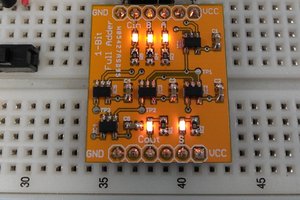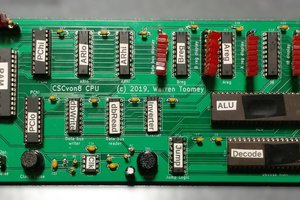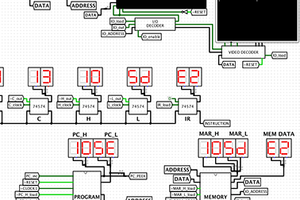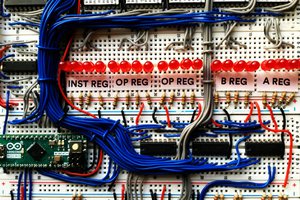INTRODUCTION & HISTORY
Tick is an experimental, 8-bit, serial arithmetic computer, built almost entirely from low cost, high speed 74HC series logic. The first prototype was built using through-hole components for relatively straight-forward home construction.
Tick was inspired by other "TTL" computer projects here on Hackaday.io, but as a novel twist, I wanted to base it on serial arithmetic and SPI - like interfaces to communicate with external memory and peripherals or sensors.
Tick came out of a presentation in 2017 regarding the Cambridge University 1949 EDSAC computer, and with discussions with colleagues in the Open Source Hardware Community, including Rick Oliver and Alan Wood - but it was 7 years ago, so those conversations are probably forgotten, during the years of my procrastination in getting the project started.
In 2018, I built up one of Marcel van Kervinck's Gigatron TTL Microcomputers - also a Hackaday Project. The Gigatron was an elegant design using about 34 74HC series ICs, plus a RAM and a ROM. It's parallel architecture was designed for the purpose of generating low resolution (1/4 VGA) 6-bit colour video.
I met Marcel on a couple of occasions and was inspired by his minimalist design. Sadly, Marcel passed away in 2021, but he will be remembered here for his tenacity and approach to creating innovative hardware from very simple logic.
The Gigatron is an 8-bit parallel, modified Harvard architecture, with separately addressed ROM and RAM memory areas with separate data buses.
I considered a 16-bit version of the Gigatron, but it would be 50+ ICs (10 ICs in the current 8-bit ALU - so double that) and it would possibly be slower than the 8-bit ALU version.
In 2020, Marcel came up with further innovative add-on boards that would allow the Gigatron to interface with serial peripherals and memory using the SPI bus. It was then that I realised that I could design a CPU that from the outset was intended for SPI communication.
Various arachnid themed project names including SPIder, MITE, Scorpion and TICK were pondered. Others including "Serial Killer" and SHREK (shift register exploration kit) were also in the running. Finally with only a few weeks left to complete the PCB layout and get prototype pcbs made, the name TICK was chosen for the first offering.
TICK is laid out on a 4-layer pcb with power and ground planes on the internal layers. All routed signals are on the outer 2 layers, making them accessible and modifications easy.
The next version of the TICK pcb will be produced and assembled with sponsorship from pcbway.
https://www.pcbway.com/
0%
0%
TICK - a novel homebrew MCU architecture in 28 ICs
TICK is an 8-bit, bit serial CPU built onto a 110x110 4-layer pcb.
Tick uses through-hole components - you can solder it up in an afternoon!

 Dave's Dev Lab
Dave's Dev Lab
 Warren Toomey
Warren Toomey
 Ruud van Falier
Ruud van Falier
 ARITH-MATIC
ARITH-MATIC